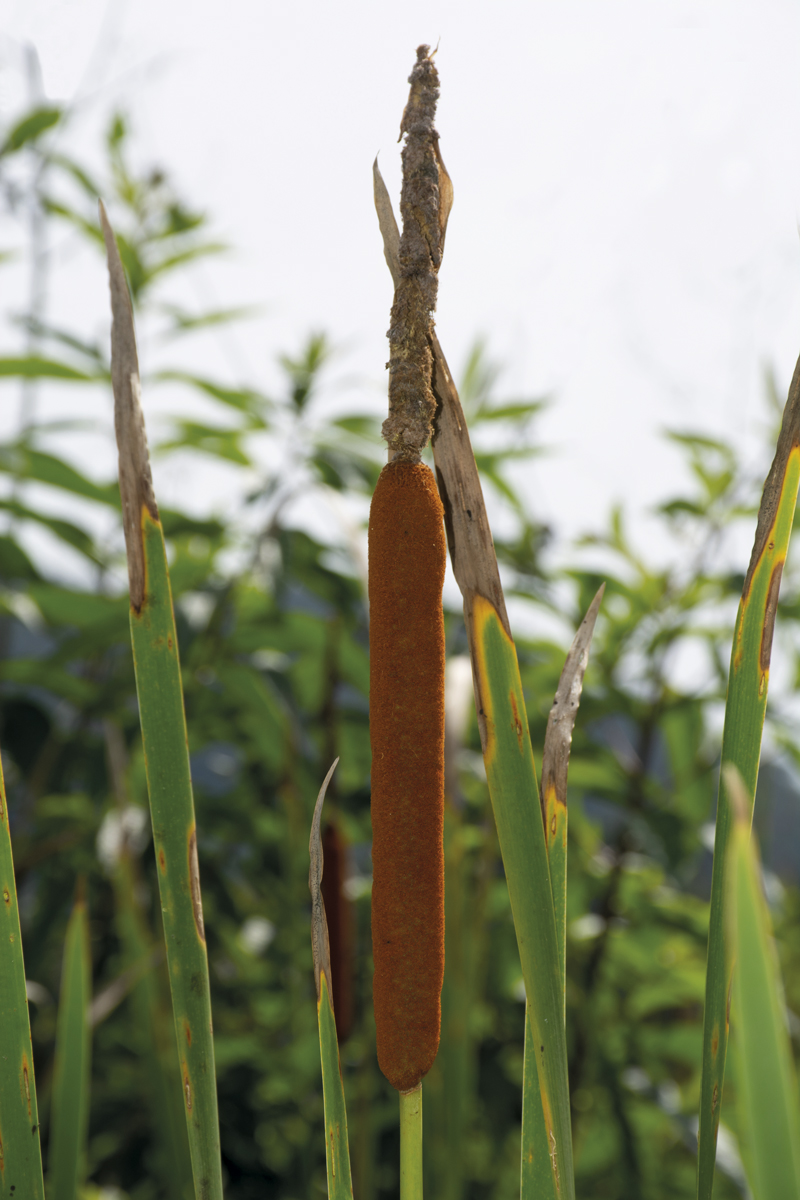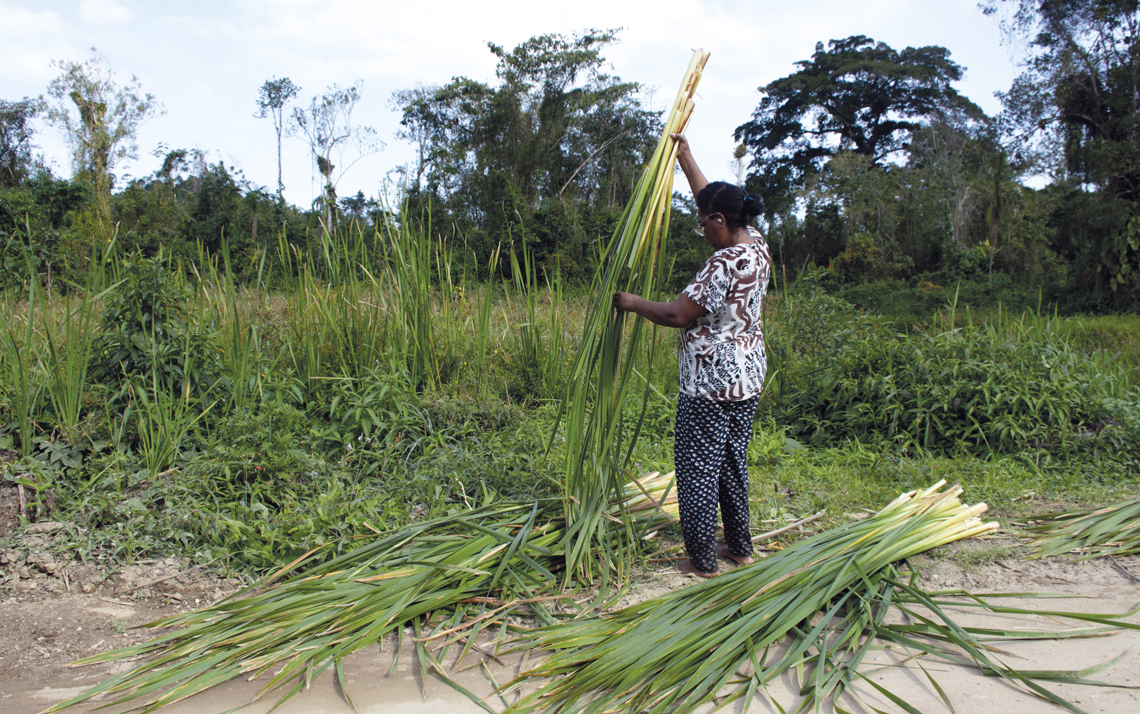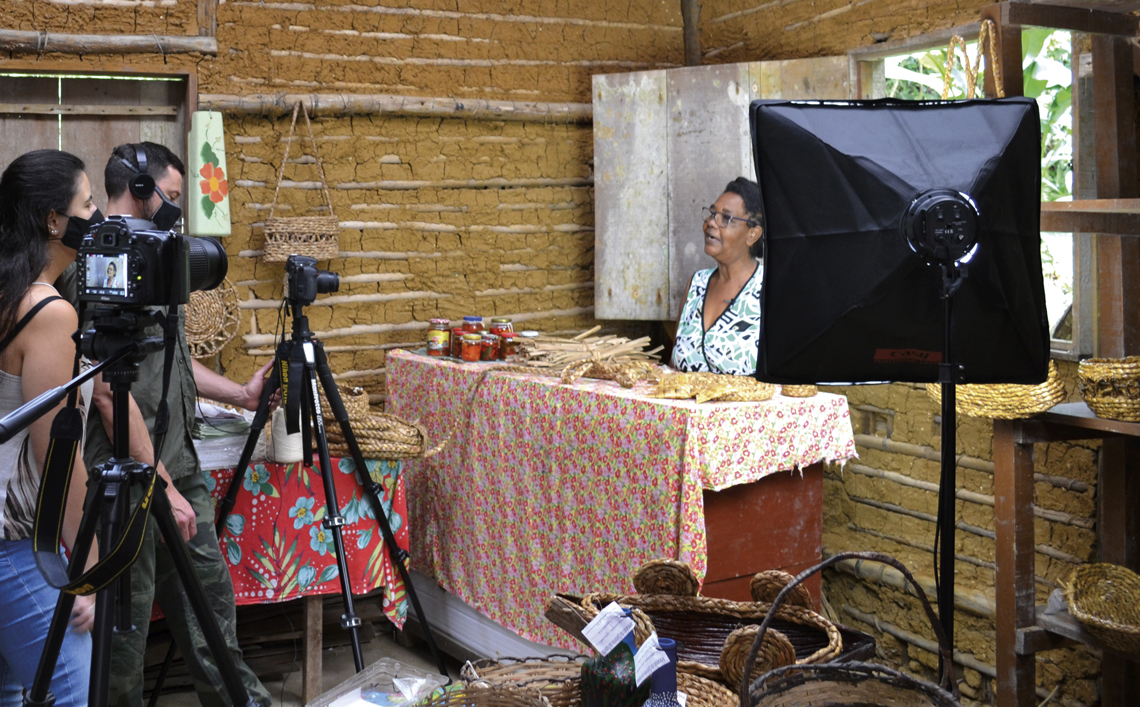When he starts to feel his throat getting scratchy, “wanting to swell up,” environmental manager Luciano Assunção heads out into the forest to find pitanga leaves. At home, he prepares a recipe he knows by heart: he steeps the leaves in hot water and makes a tea, which must be thickened in the pan with sugar until it becomes a syrup. To relieve a sore throat, it should be ingested once a day, preferably in the evening. “Just drink it and it will quickly pass,” says Assunção, who learned the recipe from his parents when he was a child. He is also the father of two young children to whom he gives the tea when needed.
The recipe is not a miracle treatment, nor was it taken from dubious internet sources, but rather it is part of the centuries-old tradition of using medicinal plants by the Quilombo da Fazenda community in Ubatuba, São Paulo. Both this recipe and 436 other uses of 221 plants were recorded in the booklet O uso das plantas pelo Quilombo da Fazenda (The use of plants by Quilombo da Fazenda), assembled by the community itself with the help of researchers from the Federal University of São Paulo’s Center for Ethnobotanical and Ethnopharmacological Studies (CEE-UNIFESP).
Since 2015, a team from the CEE has helped residents of Quilombo da Fazenda and Quilombo do Cambury—both on São Paulo’s coast—to record their knowledge on the use of local vegetation. Residents’ traditional knowledge ranges from medicinal purposes to the use of plants in handicrafts and culinary recipes. “This knowledge is passed down from generation to generation, but is being lost,” notes environmental scientist Thamara Sauini, a PhD student in chemical biology at UNIFESP and member of the CEE. Over the course of eight years, the group has produced, with the help of residents from each quilombo, five documentaries, two booklets, one manual for managing cattail (Typha domingensis)—a plant used in handicrafts—and six academic works (articles and dissertations). The most recent article, published in November in the journal PeerJ, compares the use of plants in the two quilombos (communities that, in the past, resisted the slavery system) based on participatory ethnobotany. There are also videos with instructions for making cosmetics, available on YouTube.
The methodology used by the researchers for this process was called participatory ethnobotany. “When people ask me what I, as a scientist, intend to give back to the community with this work, I say that I can’t give back something that already belongs to the community,” reflects biologist Eliana Rodrigues, coordinator of the CEE and creator of the participatory ethnobotany proposal. “They are the protagonists, the players, the researchers in this project,” says Rodrigues. In the project’s first phase, between 2016 and 2018, residents of the two quilombos attended workshops on cultural anthropology, botany, and how to carry out ethnobotanical surveys in their territories. From 2019 onward, researchers from the university and the community implemented what they learned.

Amanda Nakadaira / UNIFESPCattail (Typha domingensis) is an aquatic plant native to BrazilAmanda Nakadaira / UNIFESP
“The community doesn’t have the resources to make a book or a movie,” says Assunção, who only uses allopathic medicine in the case of emergencies. “I always prefer medicine from the forest,” he says. For a long time, nature was the only source of medicine the community knew. It was in the late 1970s, when the Rio-Santos highway was built, that the quilombo residents began to have access to healthcare services and pharmacies in nearby towns.
In Quilombo da Fazenda, in addition to recording knowledge for future generations, there was a demand for a participatory management plan for cattail. “As the Serra do Mar State Park was established on top of our community, our gardening area became more limited and we need a record of how we manage it, showing that it is not harmful to the environment,” explains the environmental manager. According to the park, the traditional communities located in the region can use the natural resources sustainably as long as there is a management plan for each species they use.
Cattail is one of the main raw materials for Quilombo da Fazenda’s artisans. It is an aquatic plant native to Brazil which, in the hands of skilled people, can be transformed into mats, bags, hats, rugs, fruit bowls, pot holders, and even picture frames. To do this, they harvest the leaves—preferably during the week of the waning moon, when there are not many pests on the plants—in the morning, before flowering. You must wait at least three months for a new harvest. The best leaves for handicrafts are the larger ones that have not yellowed and that do not have flowers. With the raw materials in hand, the artisans dry the leaves in the sun, which can take up to three days. Then, they strip the cattails. In other words, they separate the leaves for another drying period, which can be from four to eight days, depending on weather conditions.
Once dry, the cattail straw can be stored for long periods, according to the manual Recomendações de boas práticas de manejo para o extrativismo sustentável da taboa (Recommendations for good management practices for the sustainable extraction of cattail), produced by the CEE group with Quilombo da Fazenda residents. The artisans collect the leaves according to local demand for handicraft sales. To make the handicrafts that are exhibited and sold in the quilombo’s Casa de Artesanato (Handicraft House), the leaves are braided and tied by hand.
The community requested that the researchers help prepare a management plan and the extraction manual was produced using local knowledge, rather than the other way around, which is so often the case in science. “It’s very different from when we perform a study and obtain certain findings to be applied within a community. The participatory technique originates from knowledge that these people have mastered and apply in their daily lives,” explains forestry engineer Sandra Pavan, who has a PhD in ecology from the University of São Paulo (USP) and is an environmental consultant and a member involved in the project. “That’s why it’s important for residents to get involved right from the start of the project,” she says.
 Amanda Nakadaira / UNIFESPIn the case of cattail, only those who extract it know the best way to do it. “The marshes are flooded, with knee-deep areas. But we know exactly where they are bogged down,” says Assunção, who is a craftsman and who knows the region very well—he has been working as an environmental monitor in the state park for over 20 years. “Scientific knowledge often ignores traditional knowledge, even though they complement each other. This union has all the potential to succeed,” says the quilombo resident.
Amanda Nakadaira / UNIFESPIn the case of cattail, only those who extract it know the best way to do it. “The marshes are flooded, with knee-deep areas. But we know exactly where they are bogged down,” says Assunção, who is a craftsman and who knows the region very well—he has been working as an environmental monitor in the state park for over 20 years. “Scientific knowledge often ignores traditional knowledge, even though they complement each other. This union has all the potential to succeed,” says the quilombo resident.
The bridge between formal science, carried out in universities and research centers, and the traditional knowledge of quilombola (peoples that live in remaining regions of quilombos) and Indigenous communities is not easy to build, nor is it that common, points out educator and anthropologist Antonio Carlos Benites Guarani-Kaiowá, of Mato Grosso do Sul State University (UEMS).
“This conversation is very recent: even though anthropology and social sciences in this area have existed for decades, there is resistance from academia as a whole to accept that there is no single science and that there is a lot to learn from other people who existed long before the arrival of medicine and other knowledge,” says Benites, who was born and raised in the municipality of Tacuru, in the Indigenous village of Jaguapiré, Mato Grosso do Sul. “Our knowledge comes from experience and practice, not just from talking, but from doing. It’s a science that we live.” According to him, collaborative research is key to having these two sides start listening to each other.
In his village, Benites has seen many researchers come and go. Today, he himself records local knowledge and, sometimes, performs field studies in other villages. “The role of written research is to leave traces of our resistance and our existence, both for outsiders and internally, to strengthen our space and our culture,” explains the researcher, who has focused on learning Western science, as he calls it, in order to use it to benefit his community.
According to Assunção, recording quilombola knowledge in academia is important for local communities and will open many doors. “We have other areas in the park where people who manage cattails could use our source materials to record their uses as well,” says the environmental manager. According to Rodrigues, of the CEE, the cattail management plan could serve as a source of inspiration and information for communities throughout Brazil.
Project
Participatory ethnobotany: Conservation and local development in the Serra do Mar State Park ‒ Picinguaba Center, Ubatuba, SP, Brazil ‒ phase 2 (nº 19/19313-5); Grant Mechanism Regular Research Grant, Biota Program; Principal Investigator Eliana Rodrigues (UNIFESP); Investment R$136,125.41.
Scientific articles
BENITES, A. C. Autobiografia: Uma trajetória acadêmica kaiowá e guarani: Che reko ypy ete: Temiguata ava reko nhemombeypy ambue tavyterã/kaiowá e guarani. Revista Desenvolvimento Social. Online. Dec. 20, 2022.
FRAGOSO, F. et al. Animais medicinais utilizados por duas comunidades quilombolas da Mata Atlântica, Ubatuba, São Paulo, Brasil. Revista Etnobiología. Online. Apr. 27, 2022.
RODRIGUES, E. et al. Participatory ethnobotany and conservation: A methodological case study conducted with quilombola communities in Brazil’s Atlantic Forest. Journal of Ethnobiology and Ethnomedicine. Online. Jan. 13, 2020.
SAUINI, T. Levantamento etnobotânico participativo entre os moradores do Quilombo Cambury, Ubatuba, SP, Brasil. Repositório Unifesp. Online. Feb. 28, 2019.
SAUINI, T. et al. Participatory methods on the recording of traditional knowledge about medicinal plants in Atlantic Forest, Ubatuba, São Paulo, Brazil. PLOS ONE. Online. May 07, 2020.
SAUINI, T. et al. Participatory ethnobotany: Comparison between two quilombos in the Atlantic Forest, Ubatuba, São Paulo, Brazil. PeerJ. Life and Environment. Online. Nov. 7, 2023.
YAZBEK, P. B. Levantamento etnobotânico participativo entre os moradores do Quilombo da Fazenda ‒ Núcleo Picinguaba, Ubatuba, SP, Brasil: Diálogos entre os conhecimentos tradicionais e acadêmicos. Repositório Unifesp. Online. July 25, 2018.
YAZBEK, P. B. et al. Plants utilized as medicines by residents of Quilombo da Fazenda, Núcleo Picinguaba, Ubatuba, São Paulo, Brazil: A participatory survey. Journal of Ethnopharmacology. Online. Nov. 15, 2019.
Documentaries
Etnobotânica participativa
Quilombo da fazenda ‒ Raízes de resistência
Quilombo do Cambury ‒ Herança quilombola ‒ Cambury
Como fazer um shampoo em barra?
Como fazer um esfoliante a partir da casca do coco verde (Cocos nucifera L.)
Cattail participatory management plan
Part 1: cattail participatory management plan
Part 2: cattail participatory management plan ‒ Recommended good management practices
